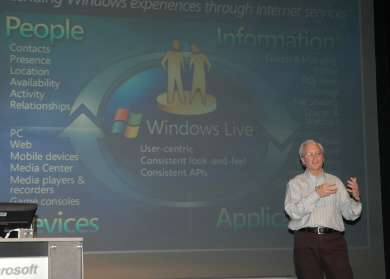Microsoft Live no jive

Sorry for the delay. The Wi-Fi cut out during the event, which wasn’t good for blogging or the product demos. In any case, the question we have all been asking the last several months is whether Microsoft can pivot deeply into the services world, and catch up or get ahead of where Google, Yahoo, AOL and a host of smaller Web-centric companies are heading.
From a technology viewpoint, Gates and Ozzie provided evidence that its notion of live software is going to be competitive with what the upstarts with billions in Web ad revenue and hundreds of millions of regular users are doing to explore and exploit the age of Internet computing. Now, Microsoft needs to show that it can follow through in delivering the initial services this year and keep up with the others who are scaling the same mountain. Even then, it will be tough to take users away from Yahoo or Google, which is why doing a deal with AOL makes even more sense beyond adCenter. Today's preview was also reminiscent of Microsoft's response to Netscape with Internet Explorer, but the end result of this transition won't be Microsoft domination.

Microsoft CTO Ray Ozzie...more photos
Microsoft showed off credible beta services (despite the crippled demos)—Windows Live and Office Live—that demonstrated an understanding of how to build Web applications and services without requiring that users pay taxes to the Windows empire. Check out live.com. Microsoft doesn't have any unique technology advantage over Google et al, but now it will be on more equal footing in terms of iterating faster and working with the user community to improve products and services, mostly for consumers. Still, Microsoft has to overcome being "Microsoft," and not Google or Yahoo, which were born of the Web, and figure out how to finesse its business model, figuring out how ad revenue and subscriptions will impact the bottom line compared to the license revenue model.
Creating a Windows Live, in addition to MSN, seems a bit counter-intuitive. It's clearly a way to expand the definition of Windows (not an old operating system), extending the life of the Windows brand. It appears that Live Windows/Office and MSN will run along parallel tracks, leveraging the same technology and potentially at some point unite.
Microsoft CTO Ray Ozzie mentioned “openness” and encouraging “conversation” in outlining the services strategy. "The walls are coming down and Microsoft cannot do it alone. [Live] will be more open and ship with quick rhythm based on conversations with users, developers and partners,” Ozzie said. He also said that at all the layers of Microsoft's software and services different members of ecosystem can participate, which implies that the company understand that to compete it has to allow developers and users to remix content and services from other providers.
During the press conference after the presentation, Ozzie talked about bringing a ‘services plus software’ mentality into many product groups in company. “Many things enterprises run in a datacenter that will over some period of time—five to ten years--will migrate toward some combined offering, some in house and some in the cloud as they deem most economical.”
CTO Ray Ozzie, MSN SVP David Cole, Business GM Rajesh Jha, Chief Software Architect Bill Gates
Microsoft's services platform will be general and comprehensive, Ozzie said. It doesn’t require Windows to use, and it will have core foundations (storage, communications, identity, relationships, advertising & billing and payment), interfaces (AJAX RSS, Web services, Client APIs & UX, native code, managed code) and solutions (Web sites, workspaces, forms & views, messaging, calendaring, libraries). In addition the platform will support not only cloud-based architectural models, but cloud-federated servers, P2P direct, P2P relayed, online and offline, Ozzie said
Windows Live is basically a new incarnation of MSN with a customizable, drag and drop start page, AJAXed email, calendaring, IM, mapping and open APIs build around the Windows brand. According to David Cole, senior vice president, MSN and Personal Services Group, Windows Live and MSN are aimed at different audiences, with MSN focused more a content portal. However, he said that Microsoft will migrate HotMail and MSN Messenger users to Windows Live Mail and Windows Live Messenger. Firefox support currently doesn’t exist for the Live platform, but will come soon, as well as for other modern browsers such as Netscape. In an ad supported model, reaching the largest number of customers is a great motivator for cross-platform support.
Office Live includes 22 applications that don’t require Office, but integrate well with it, and is aimed at small businesses (targets 10 employees or less) that need to create and host Web site, collaborate and manage customers and projects. It looks like a good package for small business that will compete with similar offering from much smaller competitors.
In response to a questions about integrating with services from Google, Yahoo and salesforce.com, for example, Ozzie said: “In the Live.com demo we showed we are embracing models to plug in arbitrary services because that’s what users want. We don’t believe we have an ability to conceptualize all the things people would like. RSS, in particular, is a really good example...it’s a world we embrace.” Gates added, “You can take our gadget and host them on other sites. It’s just an API call taking XML data. You can call Virtual Earth and render a map or call the mail API and see if new messages have arrived.”